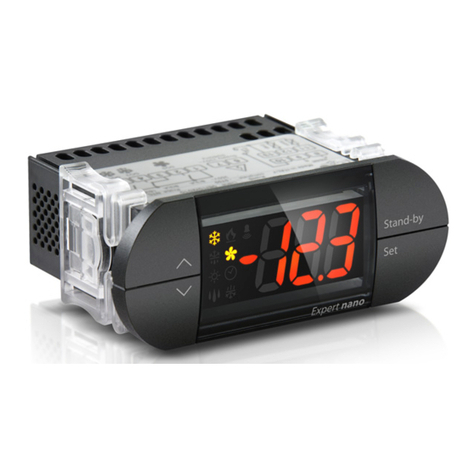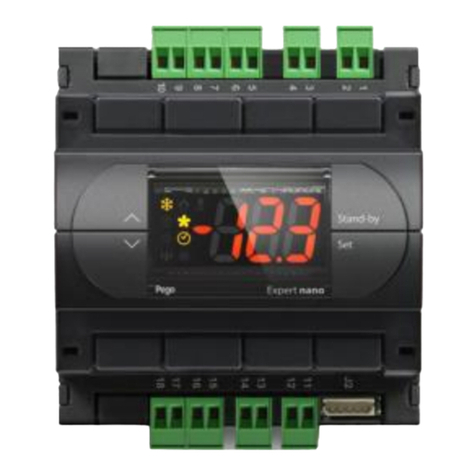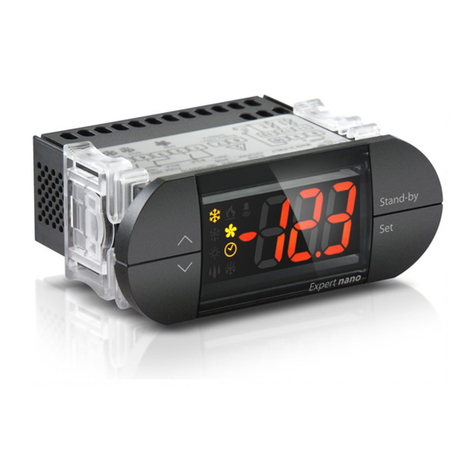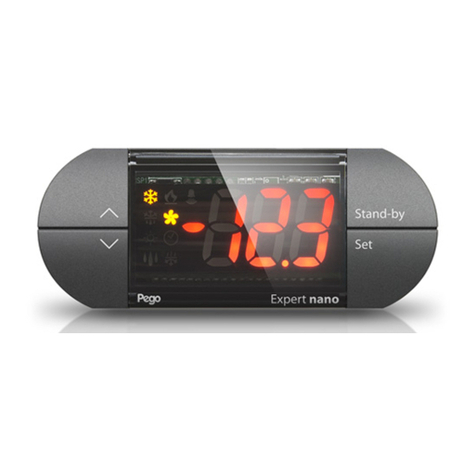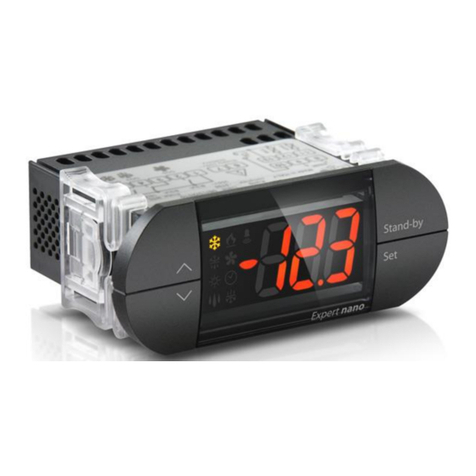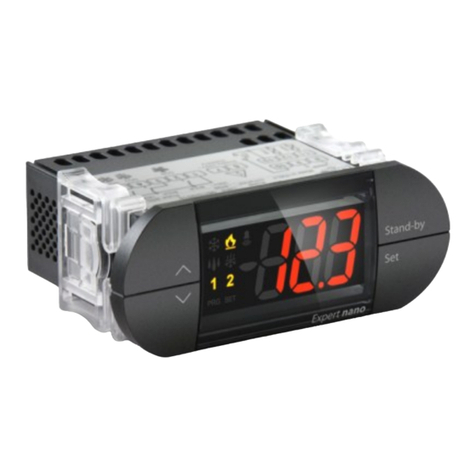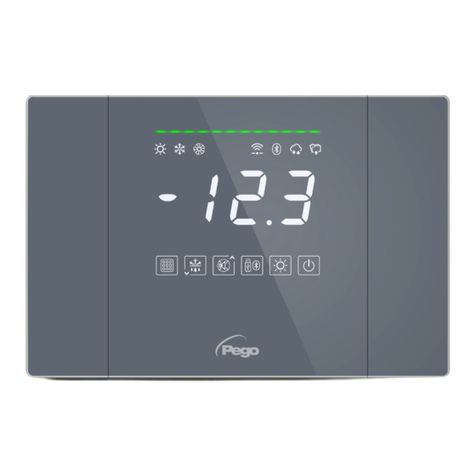
PEGO S.r.l.
Via Piacentina, 6/b - 45030 - ROVIGO
Tel : +39(0)425 762906 - Fax: +39(0)425 762905
www.pego.it - e-mail: info@pego.it
200NDIN5CK01_02-19_ITA_ENG # Rev.02-19 # 03/07/2019
ELENCO VARIABILI DI PRIMO LIVELLO
(Livello utente)
Differenziale di temperatura riferito al SET-POINT
principale.
< Range: 0,2 ÷ 10,0°C >
E’ espresso in valore assoluto e definisce l'isteresi
(positiva se mOd=0 oppure negativa se mOd=1)
della temperatura riferita al SET POINT.
Intervallo di sbrinamento.
< Range: 0 ÷ 24 ore >
Con d0=0 gli Sbrinamenti sono esclusi
Ritardo alla partenza dello sbrinamento sul
secondo evaporatore.
<Range: 0 ÷ 10 sec > - 0 = partenza simultanea
Lo sbrinamento del secondo evaporatore parte
dd2 secodi dopo la fine dello sbrinamento 1.
Questo evita di sovraccaricare l’impianto
elettrico durante uno sbrinamento in caso si
disponga di una limitata potenza. Con dd2=0 gli
sbrinamenti 1 e 2 partono simultaneamente.
dd2 viene forzato a 0 se d1 = 1 o 2. (sbrinamento
a inversione di ciclo)
Set point di fine sbrinamento evaporatore 1
< Range:-35 ÷ 45°C >
Lo sbrinamento 1 non è eseguito se la temperatura
letta dalla sonda di sbrinamento 1 è superiore al
valore d21 (In caso di sonda guasta o assente lo
sbrinamento è eseguito a tempo)
Set point di fine sbrinamento evaporatore 2
< Range:-35 ÷ 45°C >
Lo sbrinamento 2 non è eseguito se la temperatura
letta dalla sonda di sbrinamento 2 è superiore al
valore d22 (In caso di sonda guasta o assente lo
sbrinamento è eseguito a tempo)
Massima durata sbrinamento evaporatore 1
< Range: 1 ÷ 240 min >
Massima durata sbrinamento evaporatore 2
< Range: 1 ÷ 240 min >
Durata sgocciolamento.
< Range:0 ÷ 10 min >
Al termine dello sbrinamento il compressore ed i
ventilatori restano fermi per il tempo d7 impostato,
il led dello sbrinamento sul frontale del quadro
lampeggia.
Pausa ventilatori dopo lo sbrinamento.
< Range: 0 ÷ 10 min >
Permette di mantenere fermi i ventilatori per un
tempo F5 dopo lo sgocciolamento. Questo tempo è
conteggiato a partire dalla fine dello
sgocciolamento. Se non è impostato lo
sgocciolamento, al termine dello sbrinamento
avviene direttamente la pausa ventilatori.
Allarme di minima temperatura.
< Range: - 45 ÷ (A2-1)°C >
Temperatura assoluta riferita alla sonda ambiente
sotto la quale, una volta trascorso il tempo di ritardo
Ald, viene attivato l’allarme di BASSA temperatura
che consiste nell' attivazione del Buzzer (se
presente), nella scritta EL alternata alla temperatura
sul display e nel lampeggio dell'icona di presenza
allarme. Al rientro dell'allarme l'icona di "presenza
allarme" rimane accesa fissa per indicare l’avvenuto
intervento fino alla pressione del tasto UP.
Allarme di massima temperatura.
< Range: (A1+1) ÷ 99°C >
Temperatura assoluta riferita alla sonda ambiente
sopra la quale, una volta trascorso il tempo di ritardo
Ald, viene attivato l’allarme di ALTA temperatura che
consiste nell' attivazione del Buzzer (se presente),
nella scritta EH alternata alla temperatura sul display
e nel lampeggio dell'icona di presenza allarme.
Al rientro dell'allarme l'icona di "presenza allarme"
rimane accesa fissa per indicare l’avvenuto
intervento fino alla pressione del tasto UP.
Visualizzazione temperatura sonda evaporatore 1
< °C >
(non visualizza niente se dE1 =1)
Visualizzazione temperatura sonda evaporatore 2
< °C >
(non visualizza niente se dE2 =1)
Abilitazione sbrinamenti in tempo reale
evaporatori.
Con d0=0 e dFr=1 è possibile impostare fino a 6
sbrinamenti in tempo reale nell’arco di una giornata
attraverso i parametri d41…d46
Programmazione orari sbrinamenti evaporatori.
E’ possibile impostare fino a 6 orari per gli
sbrinamenti (da 00,0 ÷ 23,5)
L’orario è nella forma HH.M dove HH rappresenta
l’ora e M le decine di minuti (Es. 0=0 min; 1=10 min,
ecc.). Il punto (.) lampeggiante indica che è
visualizzato un orario e non una temperatura.
Inizio fase giorno (da 00,0 ÷ 23,5)
Valido se nonci sono ingressi digitali notte
(vedi In1, In2 e In3)
Fine fase giorno (da 00,0 ÷ 23,5)
Valido se non ci sono ingressi digitali notte
(vedi In1, In2 e In3)
ELENCO VARIABILI DI SECONDO LIVELLO
(Livello installatore)
Numero evaporatori. < Range: 1 ÷ 2 >
Se nrE=1 viene disabilitata la sonda evaporatore 2
che diventa quindi un secondo ingresso digitale (DI2).
Stato ventilatori a compressore spento.
< Range: 0 ÷ 2 >
0 = Ventilatori in marcia continua
1 = Ventilatori ON solo con il compressore ON
2 = Ventilatori disabilitati
Pausa ventilatori durante lo sbrinamento.
< Range: 0 ÷ 1 >
0 = Ventilatori ON durante lo sbrinamento
1 = Ventilatori OFF durante lo sbrinamento
TEMPERATURA blocco VENTOLE
< Range: - 45 ÷ 99°C >
Le ventole rimarranno ferme se il valore di
temperatura letto dalla sonda evaporatore1 o dalla
sonda evaporatore 2 risulterà superiore al valore di
questo parametro. Il blocco è disattivato con sonda
evaporatore disabilitata o in errore.
Differenziale per Fst.
< Range: 1 ÷ 10°C >
Esclusione sonda evaporatore 1
< Range: 0 ÷ 1 >
0 = sonda evaporatore 1 presente
1 = sonda evaporatore 1 assente
Escludendo la sonda evaporatore gli sbrinamenti
avvengono ciclicamente con periodo d0 e
terminano con scadenza del tempo d31.
Esclusione sonda evaporatore 2
< Range: 0 ÷ 1 >
0 = sonda evaporatore 2 presente
1 = sonda evaporatore 2 assente
Escludendo la sonda evaporatore gli sbrinamenti
avvengono ciclicamente con periodo d0 e
terminano con scadenza del tempo d32.
Tipo di sbrinamento.
< Range: 0 ÷ 2 >
0= a resistenza
1= ad inversione di ciclo (gas caldo)
2= ad inversione di ciclo con bacinella
3= termostatato a resistenza a tempo
Sbrinamento all’avvio
< Range: 0 ÷ 1 >
0 = disabilitato
1 = abilitato
Sbrinamento intelligente
< Range: 0 ÷ 1 >
0 = disabilitato
1 = abilitato
Setpoint sbrinamento intelligente (se dSE=1)
< Range: -30,0 ÷ 30,0 °C >
Il conteggio del tempo fra uno sbrinamento e il
successivo viene incrementato solo se il compressore
è acceso e la temperatura dell’evaporatore è
inferiore a dSt.
Tempo minimo tra lo spegnimento e la successiva
Accensione del compressore.
< Range: 0 ÷ 15 min >
Tempo di funzionamento ON compressore in caso di
sonda ambiente guasta (Funzionamento di
emergenza). < Range: 0 ÷ 240 min / 0=Disabilitato >
Con CE1=0 il funzionamento di emergenza in
presenza di errore E0 rimane disabilitato, il
compressore rimane spento e vengono inibiti gli
sbrinamenti per conservare il freddo residuo.
Tempo di funzionamento OFF compressore in caso
di sonda ambiente guasta < Range: 5 ÷ 240 >
(Funzionamento di emergenza).
Tempo di guardia compressore per micro porta.
< Range: 0 ÷ 5 min >
All’apertura del micro porta le ventole
dell’evaporatore si spengono e il compressore
continuerà ancora a funzionare per il tempo doC,
dopo si spegnerà
Tempo di reinserimento compressore dopo
l'apertura porta. (con In1 o In2 o In3= +2 o -2)
< Range: 0 ÷ 240 min / 0=Disabilitato >
All’apertura del micro porta e passato il tempo tdo
viene ripristinato il funzionamento normale del
controllo dando la segnalazione di allarme di porta
aperta (Ed)
Tempo di ritardo segnalazione e visualizzazione
allarme luce cella
< Range: 0 ÷ 240 min / 0=Disabilitato >
All’ accensione della luce con tasto UP e passato il
tempo Tdo si attiva l’allarme E9. Se viene tacitato e
non viene spenta la luce alla nuova scadenza del
tempo Tdo si ripresenta l’allarme. Se un’uscita
viene impostata come relè allarme, l’allarme E9
ecciterà il relè.
Modo di funzionamento Termoregolatore.
< Range: 0 ÷ 1 >
0 = Chiamata freddo
1 = Chiamata caldo
(in questa modalità gli sbrinamenti e il blocco
ventole Fst sono esclusi)
Impostazione Ingresso digitale DI e stato di
attivazione. < Range: -8 ÷ 8 >
8= ingresso notte (risparmio energetico) (con DI=1)
7= Pressostato di Pump-down (con DI=1)
6= Stop sbrinamento da remoto (con DI=1)
(Viene preso il fronte di salita impulso)
5= Start sbrinamento da remoto (con DI=1)
(Viene preso il fronte di salita impulso)
4= Stand-by da remoto (con DI=1) Per indicare lo
stand-by remoto viene visualizzato sul display Ino
alternato alla visualizzazione corrente
3= allarme uomo in cella (con DI=1)
2= Micro porta (con DI=1)
1= protezione compressore (con DI=1)
0= Disabilitato
-1= protezione compressore (con DI=0)
-2= Micro porta (con DI=0)
-3= allarme uomo in cella (con DI=0)
-4= Stand-by da remoto (con DI=0) (Per indicare lo
stand-by remoto viene visualizzato Ino alternato
alla visualizzazione corrente)
-5= Start sbrinamento da remoto (con DI=0)
(Viene preso il fronte di discesa impulso)
-6= Stop sbrinamento da remoto (con DI=0)
(Viene preso il fronte di discesa impulso)
-7= Pressostato di Pump-down (con DI=0)
-8=ingresso notte (risparmio energetico) (con DI=0)
Impostazione Ingresso digitale DI 2 e stato di
attivazione. < Range: -8 ÷ 8 >
8= ingresso notte (risparmio energetico) (con DI=1)
7= Pressostato di Pump-down (con DI=1)
6= Stop sbrinamento da remoto (con DI=1)
(Viene preso il fronte di salita impulso)
5= Start sbrinamento da remoto (con DI=1)
(Viene preso il fronte di salita impulso)
4= Stand-by da remoto (con DI=1) Per indicare lo
stand-by remoto viene visualizzato sul display Ino
alternato alla visualizzazione corrente
3= allarme uomo in cella (con DI=1)
2= Micro porta (con DI=1)
1= protezione compressore (con DI=1)
0= Disabilitato
-1= protezione compressore (con DI=0)
-2= Micro porta (con DI=0)
-3= allarme uomo in cella (con DI=0)
-4= Stand-by da remoto (con DI=0) (Per indicare lo
stand-by remoto viene visualizzato Ino alternato
alla visualizzazione corrente)
-5= Start sbrinamento da remoto (con DI=0)
(Viene preso il fronte di discesa impulso)
-6= Stop sbrinamento da remoto (con DI=0)
(Viene preso il fronte di discesa impulso)
-7= Pressostato di Pump-down (con DI=0)
-8=ingresso notte (risparmio energetico) (con DI=0)
Impostazione Ingresso digitale DI 3 e stato di
attivazione. < Range: -8 ÷ 8 >
8= ingresso notte (risparmio energetico) (con DI=1)
7= Pressostato di Pump-down (con DI=1)
6= Stop sbrinamento da remoto (con DI=1)
(Viene preso il fronte di salita impulso)
5= Start sbrinamento da remoto (con DI=1)
(Viene preso il fronte di salita impulso)
4= Stand-by da remoto (con DI=1) Per indicare lo
stand-by remoto viene visualizzato sul display Ino
alternato alla visualizzazione corrente
3= allarme uomo in cella (con DI=1)
2= Micro porta (con DI=1)
1= protezione compressore (con DI=1)
0= Disabilitato
-1= protezione compressore (con DI=0)
-2= Micro porta (con DI=0)
-3= allarme uomo in cella (con DI=0)
-4= Stand-by da remoto (con DI=0) (Per indicare lo
stand-by remoto viene visualizzato Ino alternato
alla visualizzazione corrente)
-5= Start sbrinamento da remoto (con DI=0)
(Viene preso il fronte di discesa impulso)
-6= Stop sbrinamento da remoto (con DI=0)
(Viene preso il fronte di discesa impulso)
-7= Pressostato di Pump-down (con DI=0)
-8=ingresso notte (risparmio energetico) (con DI=0)
Impostazione funzionalità uscita digitale DO2.
< Range: -7 ÷ 7 >
7= Relè DO2 resistenze di sbrinamento evap. 2 NO
6= Relè DO2 resistenze di sbrinamento evap. 1 NO
5= Relè DO2 eccitato con richiesta freddo attiva
(solenoide evaporatore). L'uscita DO1 viene
attivata dall' ingresso digitale configurato come
pressostato di Pump-down (In1/2/3=7 o –7)
4= Uscita Luce cella (Si attiva automaticamente
con porta aperta o allarme uomo in cella E8) NO
3= Relè eccitato in modalità notte
2= Relè DO2 eccitato con uscita compressore DO1
eccitata. Usato per unità motocondensante.
1= Relè DO2 eccitato in presenza di allarme
0= Relè DO2 Disabilitato
-1= Relè DO2 diseccitato in presenza di allarme
-2= Relè DO2 diseccitato con uscita compressore
DO1 eccitata. Usato per resistenza carter.
-3= Relè diseccitato in modalità notte
-4= Uscita Luce cella (Si attiva automaticamente
con porta aperta o allarme uomo in cella E8) NC
-5= Relè DO2 diseccitato con richiesta freddo attiva
(solenoide evaporatore). L'uscita DO1 viene
attivata dall' ingresso digitale configurato come
pressostato di Pump-down (In1/2/3=7 o –7)
-6= Relè DO2 resistenze di sbrinamento evap. 1 NC
-7= Relè DO2 resistenze di sbrinamento evap. 2 NC












